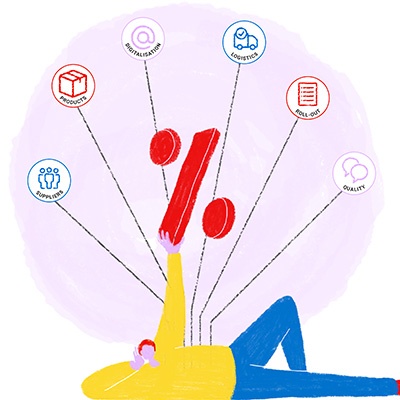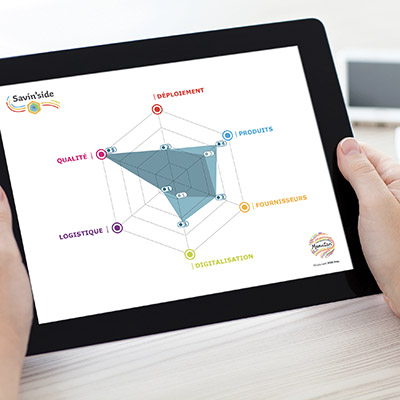In a context where companies are constantly seeking to improve their competitiveness, the procurement process plays a strategic role. Optimising procurement practices is no longer limited to cost savings: it forms part of a genuine digital transformation. Adopting high-performance technological tools enables streamlined procurement management whilst generating added value at each stage of the process.
Why optimising the procurement process is essential for company performance
The procurement process plays a central role in the overall strategy of any company. Optimising it, particularly through digitalisation, enables improved efficiency, enhanced relationships with suppliers and generates added value at each stage of the procurement process.
Definition and objectives of the procurement process
The procurement process encompasses all the steps, from identifying requirements to negotiation and contracts monitoring. It differs from supply, which corresponds to the operational execution of orders. A proper definition of this process enables structuring internal organisation, strengthening procurement management and optimising performance evaluation.
The objectives are multiple:
- Cost reduction;
- Service improvement;
- Expenditure rationalisation;
- Improved supplier relationships;
- Compliance adherence.
This involves mobilising competent internal teams, clearly identifying requirements through precise specifications as well as using effective selection, sourcing and negotiation techniques.
Expert analysis
"There is an efficiency issue with buyers. Digitalisation will help us address this. Furthermore, there is an economic issue: just because the purchase price is low doesn't mean that management costs and administrative costs are not significant."
--- Natacha Tréhan, Senior Lecturer, Grenoble IAE[1]
Benefits of procurement digitalisation
Digitalisation of the procurement process enables automating many time-consuming tasks: invoice management, competitive bidding, specifications or contracts monitoring. E-procurement software facilitates collaboration between teams, streamlines supplier relationships and provides better data analysis for continuous performance evaluation.
By integrating these tools into the company’s procurement process, we improve management and traceability, creating conditions for more strategic, sustainable and results-oriented procurement. Each phase thus becomes an opportunity for savings and value creation for the company.
Expert analysis
"Digitalisation is absolutely necessary. We have very high volumes, which makes it impossible to optimise our processes without it. Digitalisation allows us to grow with the company and support development needs."
--- Évelyne Mercier, Chief Financial Officer, Manutan France[2]
Procurement process key steps to digitalise for greater efficiency
Each procurement process relies on well-defined stages, which can now be optimised through specific digital tools. This transformation enables each team to increase responsiveness, improve service quality and maximise generated value.
Requirements identification
The first step involves conducting an internal audit to precisely request the goods or services the business needs. It is essential here to structure clear specifications, involving stakeholders to formulate exact requirements.
Once requirements are defined, market analysis enables identifying the most relevant partners. This analysis can be accelerated through digital solutions capable of cross-referencing internal data with available offers. The objective is to establish solid foundations for the next procurement process steps, whilst strengthening coherence between company strategy and mobilised skills.
Supplier research and selection
Supplier selection relies on precise criteria:
- Value for money;
- Delivery times;
- Regulatory compliance;
- Innovation;
- Logistics capabilities...
Specialised platforms now enable conducting this evaluation objectively, quickly and traceably.
Sourcing techniques are modernising through the use of databases, rating tools or recommendation algorithms. This greatly facilitates competitive bidding, enabling procurement departments to compare proposals according to standardised criteria. Partner relationships are also streamlined, paving the way for sustainable and mutually beneficial collaborations.
Negotiation, contractualisation and monitoring
Negotiation is a key phase where the procurement team ensures obtaining the best conditions whilst securing contract quality. Contract management tools enable automating drafting, monitoring commitments and generating alerts in case of deviation.
Lastly, performance monitoring relies on procurement KPIs (key performance indicators), essential for adjusting practices over time. Digitalising this step enables better anticipation, increased responsiveness and continuous management of selected supplier commitments.
Which tools to optimise procurement management and succeed in digital transformation?
As the procurement process becomes increasingly strategic, digital tools enable companies to gain agility, transparency and performance. Digitalisation of procurement management thus constitutes a powerful lever for strengthening efficiency at each stage of the procurement process.
Overview of market technologies and software
Software solutions available today offer a wide range of functionalities to automate and optimise activities related to the procurement process. Among them, we notably find:
- P2P tools (Purchase-to-Pay, or Procure-to-Pay), which cover the entire procurement cycle up to invoice payment.
- ERP and SRM systems, which centralise company data, streamline exchanges with suppliers and facilitate budget monitoring.
- TMS platforms (Transport Management System), useful in companies with significant logistics issues.
These technologies enable achieving substantial savings by automating low-value-added tasks (receiving competitive bids, processing contracts, invoice management, etc.). They also improve supplier relationships through better communication and continuous performance evaluation.
Collaborative platforms also reinforce coordination between internal teams and external partners, whilst ensuring procurement compliance with criteria defined in specifications.
E-procurement at Manutan: a turnkey solution
Manutan offers a high-performance e-procurement solution, designed to automate and simplify the company’s procurement process. Integrated and customisable, it enables significant cost reduction and precious time savings for procurement teams.
Procurement digitalisation: a concrete success example
Let's take the example of a medium-sized industrial company faced with largely manual procurement management. Order monitoring was done through Excel files, exchanges with suppliers were fragmented and internal validations lacked structure. This context resulted in significant time loss, poor commitment traceability and difficulty controlling indirect costs.
With the logic of continuous improvement and overall performance, the company made the decision to implement a P2P-type digital solution (Purchase-to-Pay, or Procure-to-Pay). This platform covered the entire procurement cycle (request, validation, sourcing, contractualisation, order, reception and payment). It was integrated with the existing ERP system and progressively deployed across different group entities.
Thanks to this transformation, several benefits were observed after one year:
- 18% savings on indirect costs, notably through the reduction of maverick spend and better negotiation;
- 40% time savings on processing standardised procurement requests;
- Better budget control through data centralisation and real-time visibility on commitments;
- Significant reduction in paper usage, forming part of a CSR approach;
- Improved supplier relationships, facilitated by process transparency and automated performance evaluations.
This project also demonstrated the importance of change management, with appropriate training for teams and strong involvement from operational management. By moving from fragmented operations to a digitalised and coherent process, the company transformed its procurement function into a strategic competitiveness lever, more agile, more traceable and creating long-term value.
You will have understood that optimising the procurement process through digitalisation enables companies to gain efficiency, transparency and control. By modernising every step, they establish foundations for a more efficient, sustainable procurement function resolutely focused on the future.
[1] Natacha, TRÉHAN (Senior Lecturer, Grenoble IAE), Le débat, SMART @WORK, 5 December 2020, 27 min, B-Smart, [https://www.bsmart.fr/video/2063-smart-work-emission-05-decembre-2020]
[2] Évelyne, MERCIER (Chief Financial Officer, Manutan France), Le débat, SMART @WORK, 4 May 2024, 22 min, B-Smart, [https://www.bsmart.fr/video/24206-smart-work-04-mai-2024]





_1110x555.jpeg)



